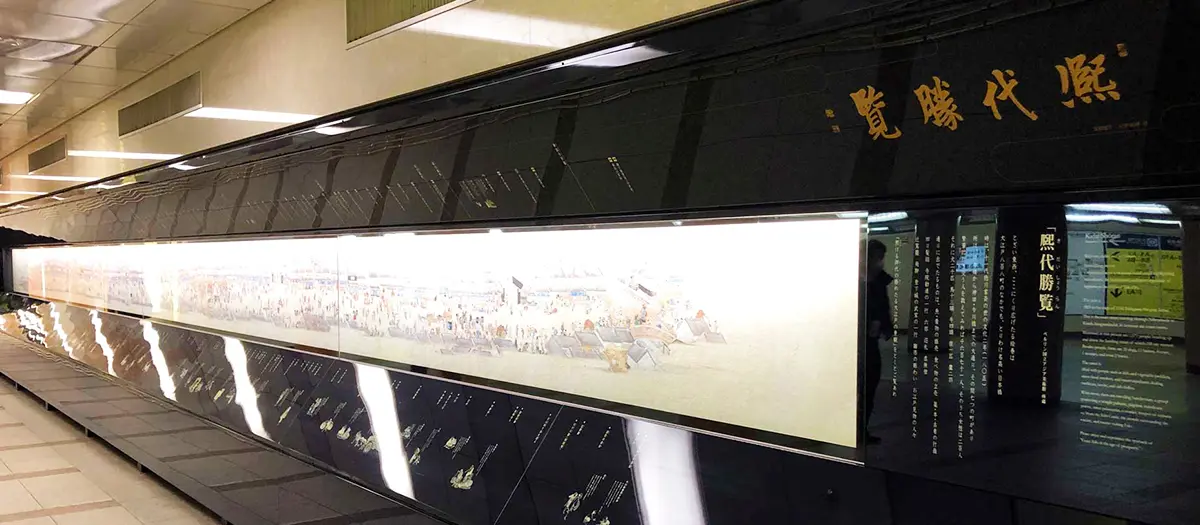
- Share this page
Share this page
- EN
Select Language
- FAVORITES
- Search
Detailed search: You can do a detailed search by keyword, genre, time, area and tag.
Main content starts here.
- Visit Tokyo |
- SPOT |
- Waterfront |
- A Link to Tokyo’s Past Through an Edo-period Scroll
Updated: November 13, 2025
A Link to Tokyo’s Past Through an Edo-period Scroll
Nihonbashi has a lively history
The Nihonbashi Bridge has been at the center of life in Tokyo (formerly known as Edo) since the days of the Edo period (1603–1867). This iconic area where the busy waterfront met a bustling shopping street was documented in a magnificent painted scroll at the beginning of the 19th century.
Tips
- A large-sized replica of the Kidai Shoran scroll hangs on the concourse wall of the Tokyo Metro Mitsukoshimae Station
- More information about the scroll is available at the Kidai Shoran Nihonbashi Guide website
- Local river cruises are a great way to enjoy Nihonbashi’s ancient connections with the city’s waterways
- A visit to Nihonbashi Tourism Information is highly recommended for everything from pamphlets to souvenirs
The Kidai Shoran Scroll: Tokyo Street Life in the Edo Period (1603–1867)
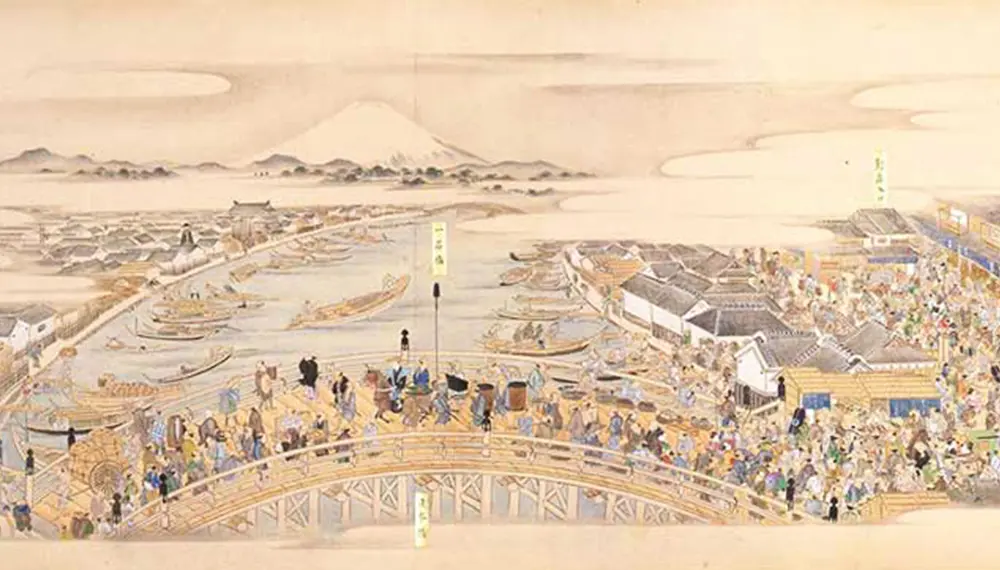
Kidai Shoran (detail) © Staatliche Museen zu Berlin, Museum für Asiatische Kunst (Asian Art Museum, National Museums in Berlin), former collection of Hans-Joachim and Inge Küster, gift of Manfred Bohms 2002, photography: Tadao Kodaira
A large painting offers a cinematic look at the times
The scroll known as Kidai Shoran (Excellent view of this prosperous age) is a 12-meter-long painting that illustrates the life and culture of the most important thoroughfare of Edo. It depicts the main shopping road from the bridge at Imagawabashi to the bridge at Nihonbashi. It is believed have been painted by a well-known artist, but its provenance is somewhat of a mystery.
The painting includes 1,671 people from all walks of life, from samurai to tradesman, students, itinerant musicians, and geisha. There are 20 dogs, 13 horses, two falcons, four oxen and a monkey. The illustrated shops include tea houses, sushi stalls, and cutlery shops, book shops and soba restaurants, tiny corner stores and the precursors of today’s prestigious department stores.
Unfortunately, the Great Fire of 1806 destroyed much of the area. Though fires were so common that they were called “flowers of Edo,” and rebuilding was a regular part of life, the scroll remains an important record of the times.
In 2009 a 17-meter-long reproduction of the painting was printed and installed on the wall of the underground concourse of Tokyo Metro’s Mitsukoshimae Station. Also on display are panels in Japanese explaining various aspects of the people, buildings, occupations, and Edo-period culture that are depicted in the scroll. Explanations in English can be found on the home page Kidai Shoran Nihonbashi Guide.
The Kidai Shoran scroll is on permanent exhibit at the Asian Art Museum, National Museums in Berlin.
All Roads (and Sea Routes) led to Nihonbashi
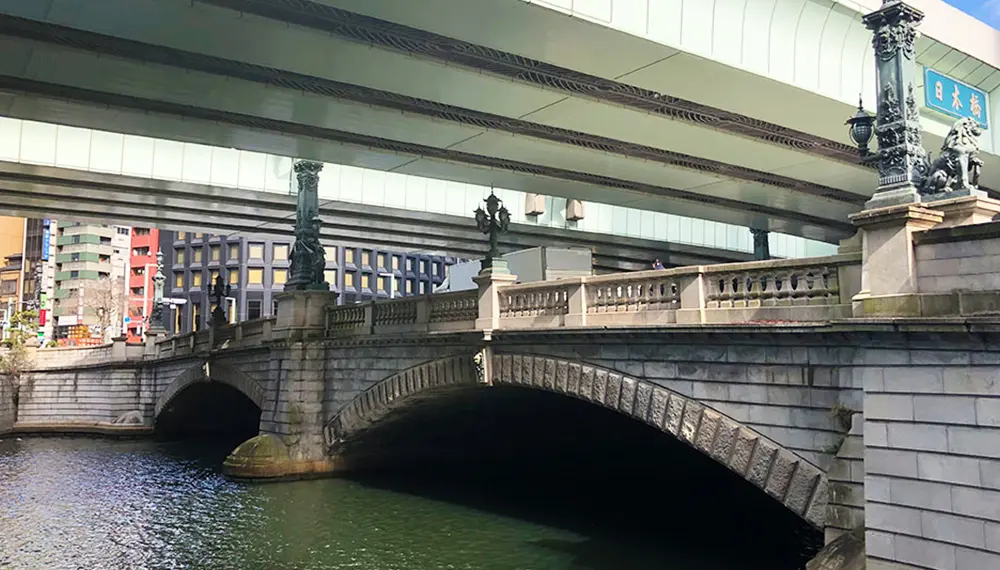
The center of commerce during the Edo period (1603–1867)
The bridge at Nihonbashi crosses the Nihonbashi River, a distributary of the Kanda River that connects to the bay and the ocean waters beyond. This neighborhood was the nexus of Japan’s land and sea routes, and distances to important cities such as Kyoto, as well as the remote provinces, were all measured from this bridge. The harbor was shared by fishermen and cargo haulers, as the easy access made it the wholesale center for many of the products meant for the one million people who lived in Edo at the time.
Scenes from the Kidai Shoran scroll (below left) show fish caught in the nearby seas being unloaded from high speed rowboats.
Today, Nihonbashi is mostly known for its business district and department stores, but visitors can explore the area’s waterfront on boats departing from the Nihonbashi landing for sightseeing tours along the Sumida and Kanda rivers (below right).
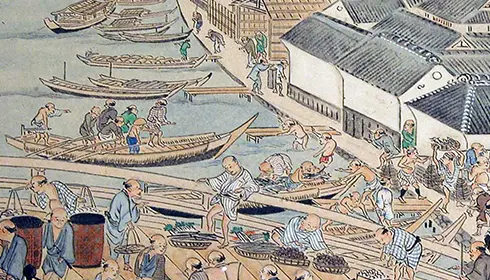 Kidai Shoran (detail) © Staatliche Museen zu Berlin, Museum für Asiatische Kunst (Asian Art Museum, National Museums in Berlin), former collection of Hans-Joachim and Inge Küster, gift of Manfred Bohms 2002, photography: Tadao Kodaira
Kidai Shoran (detail) © Staatliche Museen zu Berlin, Museum für Asiatische Kunst (Asian Art Museum, National Museums in Berlin), former collection of Hans-Joachim and Inge Küster, gift of Manfred Bohms 2002, photography: Tadao Kodaira
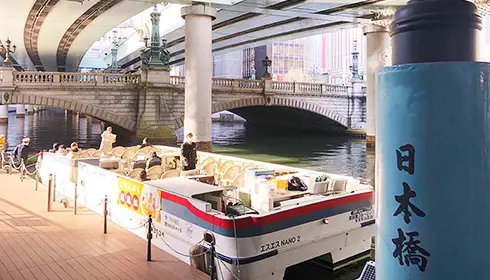
Centuries of Supplying Edo with Fresh Fish (and more)
Lively markets were a symbol of the city’s spirit
Until the Great Kanto Earthquake of 1923, Nihonbashi was the historic home of the riverside fish market that fed Edo’s population. It was then moved to the Tsukiji area before moving to its present home in Toyosu. A scene of the fish market area in the Kidai Shoran scroll (below left) shows men shouldering baskets of fish just unloaded from barges at the water’s edge while a fishmonger sells the fresh fish at his small stand.
The Nihonbashi neighborhood is still home to many retailers that boast long histories. Ninben (below right), a specialty shop selling dried bonito and dashi, the fish stock essential to Japanese cuisine, was founded in 1699.
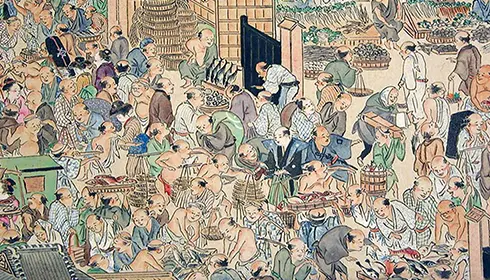 Kidai Shoran (detail) © Staatliche Museen zu Berlin, Museum für Asiatische Kunst (Asian Art Museum, National Museums in Berlin), former collection of Hans-Joachim and Inge Küster, gift of Manfred Bohms 2002, photography: Tadao Kodaira
Kidai Shoran (detail) © Staatliche Museen zu Berlin, Museum für Asiatische Kunst (Asian Art Museum, National Museums in Berlin), former collection of Hans-Joachim and Inge Küster, gift of Manfred Bohms 2002, photography: Tadao Kodaira

Popular Restaurants and the Origins of “Fast Food”
Nihonbashi was (and is) a culinary destination
The scroll shows a number of dining places along the main thoroughfare. Among them are the popular yatai, or street stalls, that served “fast food” and were set up at temporary locations along the street. In the one of the scroll’s scenes (below left), the indigo-and-white checkered pattern on the roof of the small stall identifies it as a teahouse, the Edo-period version of today’s open-air cafes.
There are still many restaurants in Nihonbashi serving traditional cuisine, such as soba, grilled eel, and tempura, that were established many years ago. The tempura restaurant Tenmo (below right) is one of them, founded in the Meiji era.
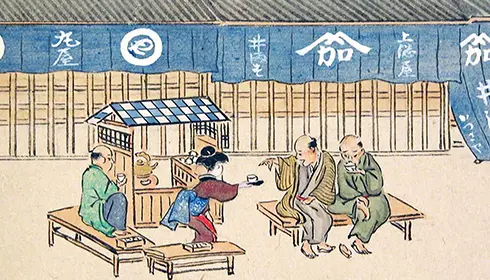 Kidai Shoran (detail) © Staatliche Museen zu Berlin, Museum für Asiatische Kunst (Asian Art Museum, National Museums in Berlin), former collection of Hans-Joachim and Inge Küster, gift of Manfred Bohms 2002, photography: Tadao Kodaira
Kidai Shoran (detail) © Staatliche Museen zu Berlin, Museum für Asiatische Kunst (Asian Art Museum, National Museums in Berlin), former collection of Hans-Joachim and Inge Küster, gift of Manfred Bohms 2002, photography: Tadao Kodaira
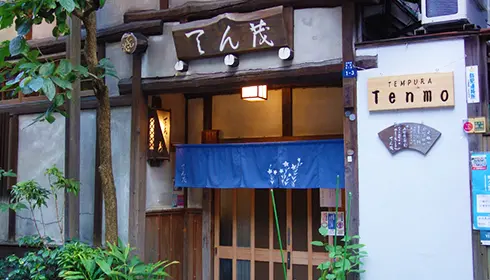
Edo People were Eager Consumers of Information
From news to gossip, Nihonbashi was ground zero for information
Nihonbashi was the center of all sorts of information, both for the people of Edo, and for dissemination to the rest of the country. Book shops and publishers were located on the main street. Official notices were posted on bulletin boards, while illicit newspapers were hawked by vendors who read the latest news out loud. A scene in the Kidai Shoran scroll even shows couriers (below left), who delivered letters, parcels, and goods—precursors of modern mail services.
It may be no coincidence that Nihonbashi is known as the birthplace of today’s postal service, with the original ministry of posts and the first post office established in 1871, honored by a monument (below right).
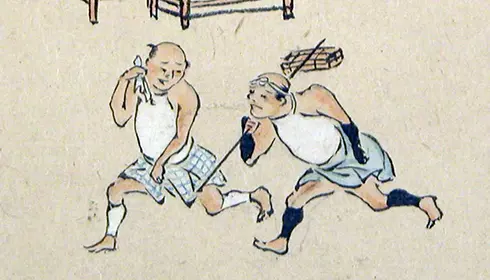 Kidai Shoran (detail) © Staatliche Museen zu Berlin, Museum für Asiatische Kunst (Asian Art Museum, National Museums in Berlin), former collection of Hans-Joachim and Inge Küster, gift of Manfred Bohms 2002, photography: Tadao Kodaira
Kidai Shoran (detail) © Staatliche Museen zu Berlin, Museum für Asiatische Kunst (Asian Art Museum, National Museums in Berlin), former collection of Hans-Joachim and Inge Küster, gift of Manfred Bohms 2002, photography: Tadao Kodaira
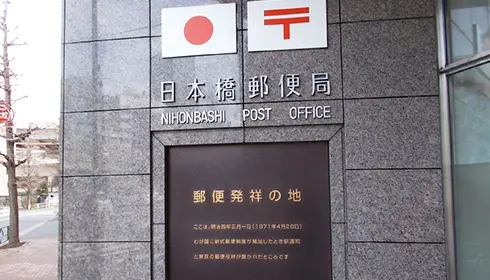
Sustainable Living in the Edo Period
An ecological society with little waste
By most modern definitions, Japan in the Edo period was a sustainable society. Little was thrown away, and most items, including clothing, tools, even human waste, was either recycled or repurposed. This is illustrated by a scene in the Kidai Shoran scroll (below left) of a man measuring the weight of scrap paper he wants to purchase. This would be recycled into new paper, for use as toilet paper, etc.
The spirit of a sustainable lifestyle is still alive in Nihonbashi. It is represented in such shops as Kiya (below right), a shop that sells and maintains kitchen knives and cutlery. Kiya is clearly depicted in the Kidai Shoran scroll, and is still in business today. Another Nihonbashi establishment, Kanako Designs, still follows the Edo-period custom of taking apart kimono and repurposing the material.
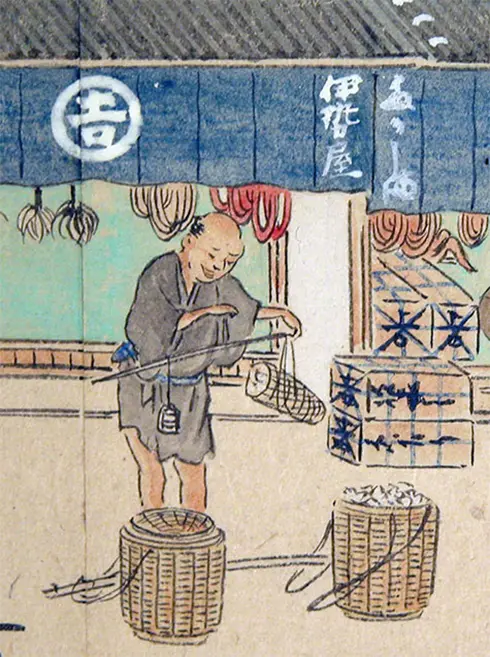 Kidai Shoran (detail) © Staatliche Museen zu Berlin, Museum für Asiatische Kunst (Asian Art Museum, National Museums in Berlin), former collection of Hans-Joachim and Inge Küster, gift of Manfred Bohms 2002, photography: Tadao Kodaira
Kidai Shoran (detail) © Staatliche Museen zu Berlin, Museum für Asiatische Kunst (Asian Art Museum, National Museums in Berlin), former collection of Hans-Joachim and Inge Küster, gift of Manfred Bohms 2002, photography: Tadao Kodaira
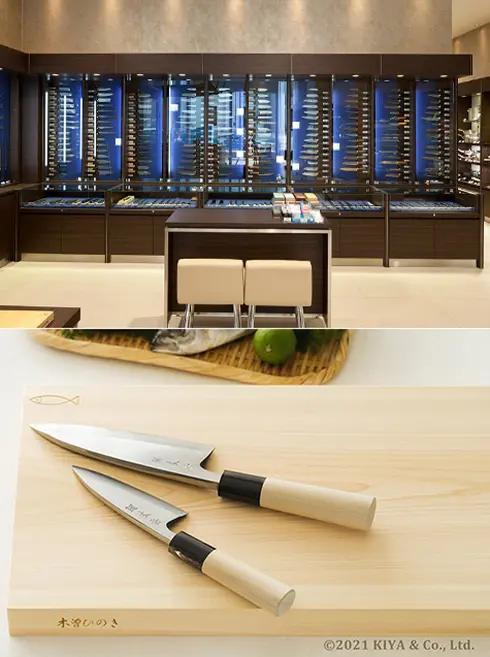
Enjoying Nihonbashi, Past and Present
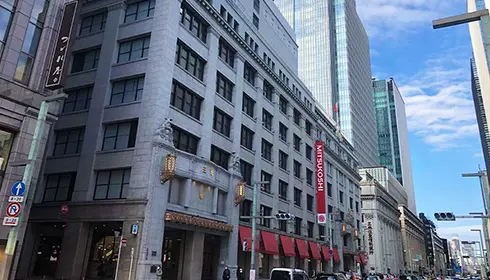
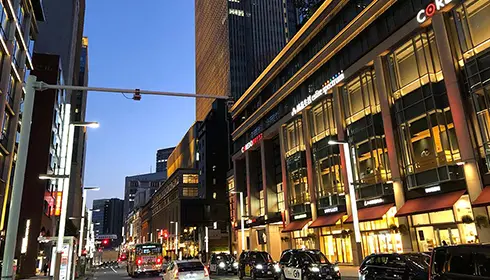
The main shopping street illustrated in the Kidai Shoran scroll has become a major thoroughfare through the center of Nihonbashi (above). Tourist information is available at the Nihonbashi Tourism Information center, which has multi-lingual staff, pamphlets, cruise and shopping information (and free wi-fi), and from these sites.
Some informative links for easy access to the streets of Nihonbashi
Nihonbashi Tourism Information
- Links useful for walking around Nihonbashi (Kidai Shoran Nihonbashi Guide)
- Nihonbashi (The Official Tokyo Travel Guide, GO TOKYO)
Tourism Information Center
Free shuttle buses in the area (in Japanese)
- Yaesu, Kyobashi, and Nihonbashi area (Metrolink Nihonbashi)
- Tokyo Station, Hamamachi, Ningyocho and Kabutocho area (Metrolink Nihonbashi E Line)

